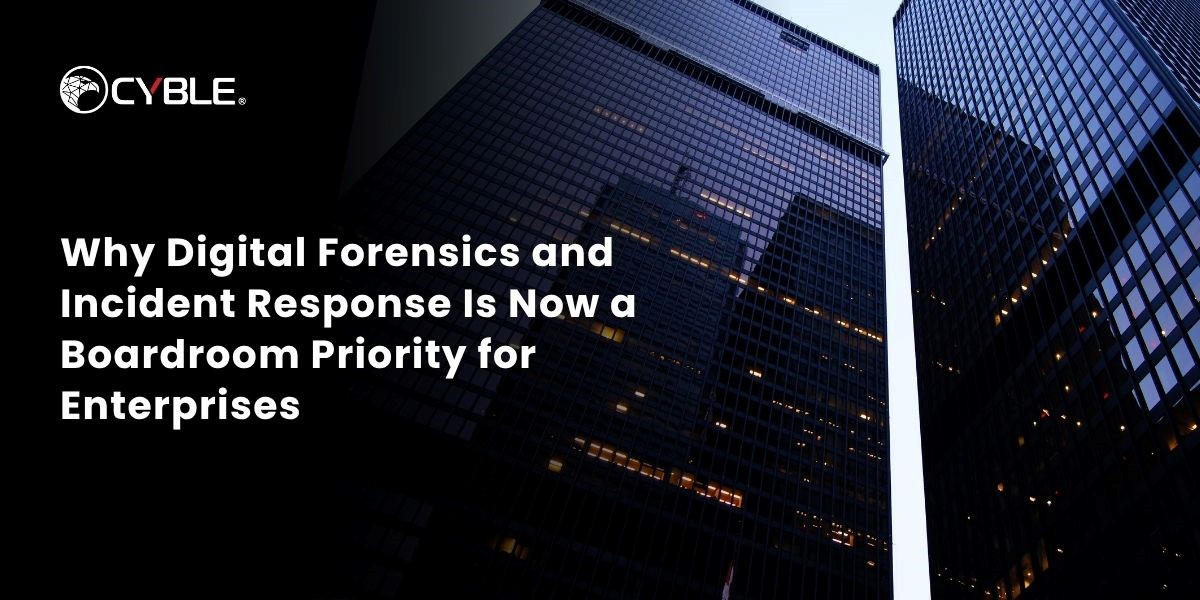In the past, digital forensics and incident response (DFIR solutions) were considered a technical exercise done after an incident. Work was primarily focusing on determining what was comprised and mitigated afterward. However, the threat landscape has changed.
Now, all types of attacks take place with increased speed and greater technical complexity, and they tend to target disruption of business versus theft of data. For example, a ransomware event against a manufacturing company could take down production lines, disrupt the supply chain, and fail its stock price overnight.
Digital Forensics and Incident Response is now deemed essential to the continuity of a business, not just the recovery of IT. Thus, “cybersecurity boardroom priority” is now a normalized term referenced in corporate governance. The board is learning a cyber incident has implications for operation/regulatory compliance/integrity of brand.
Why Digital Forensics and Incident Response Matters
Every second counts when a breach occurs. The incident response strategy lays out how quickly and effectively a company reacts to the incident.
What is being done to stop the attack is important, but it is also important to figure out how the attack was able to happen, collect evidence, and repair the systems in a way that will not contaminate the data. Digital forensics is an important part of the incident response process that helps to understand ‘the how and why’ after an incident occurs.
Digital forensics includes investigating and tracking malicious activity to understand the digital footprint, allowing investigators to piece together a narrative of what happened. For instance, someone might be able to glean the fact that a bad actor gained access through a compromised vendor account.
Understanding how the breach occurred is useful and will inform preventive steps after the event to ensure that the breach does not occur again.
The boards of directors are increasingly posing challenging questions:
- How ready are we for a cybersecurity incident?
- Are we deploying an enterprise framework for incident response planning?
- Are we appropriately managing our digital evidence for legal and regulatory purposes?
These questions are not solely the responsibility of the information technology director; they are compelling as part of board oversight of the cybersecurity issue.
The Cost of our Inaction
Cybersecurity incidents can be expensive when we react to them. Organizations that do not have an effective incident response plan will experience longer periods of lost capacity, increased costs associated with recovery, and all possible exposure to litigation.
Consider the illustration of a global retail company that experienced a significant data breach. The lack of effective management of digital evidence meant investigators were unable to demonstrate to regulators the extent of breach. In turn, this resulted in larger court fines and loss of confidence from customers that would take years to restore.
The board’s take-away is clear – proper planning pays. A well-thought-out cybersecurity risk management framework in concert with digital forensics and incidents capabilities, will help organizations minimize damage to both its finances as well as reputation.
Moving from Compliance to Confidence
Regulations today require accountability. The frameworks surrounding GDPR and other privacy-related statutes, require organizations to report breaches quickly, as well as demonstrate ownership of the data held by that organization. Cybersecurity compliance and governance will ultimately be the greatest determinants to the sustainability and viability of any organization operating in the digital environment.
A mature capability in Digital Forensics and Incident Response will enable enterprises to meet these responsibilities with confidence, while also providing enterprises the comfort of knowing, they can discover, document, and respond to incidents, in as likely a manner as possible, to that which courts would find adequate under the law. When forensic readiness and incident response plan become part of the corporate DNA, an organization’s cyber resilience is enhanced. It inspires confidence for all stakeholders that an organization can manage crises without descending into chaos.
At Cyble, the Digital Forensics and Incident Response team aims to function not just as a post-incident capacity but rather to assist in the whole process before, during, and after the incident. The company is playing an active role in helping organizations to not only handle but also to recover from cybersecurity incidents with less effort each time. The Cyble Cybersecurity Data Model guarantees the protection and the preparation of the enterprise against the ever-changing cyber threats and the resilience of the enterprise to the incident.
The firm’s skill in threat detection and response chooses the businesses not only to know the breaches but also to recognize their root causes. In case of a cyber crisis, Cyble not only incident response but also the digital evidence management allows the enterprises to make the right choices through effective communication during and after.
Such a level of preparedness converts cybersecurity from something that is only done in response to an incident into a proactive barrier. It corresponds with the objectives concerning the upper management level that are safeguarding of the assets, ensuring of the compliance, and maintaining of the continuity of the operations.
Cultivating a Preparedness Culture
The most effective incident response behaviors begin with the awareness. Cybersecurity must be a universal responsibility—from senior managers to the staff in the front lines—this is the policy that boards should support. Continuous practice, forensic readiness tests, and tabletop drills allow the teams to react with a composed mind and in an effective manner when the real danger comes.
Further to that, cooperation among the legal, compliance, and IT departments enhances the accountability chain. If these functions get together under the board’s leadership, the firm will grow stronger and become more flexible in dealing with the cyber threats.
A Boardroom Imperative
In today’s digital economy, Digital Forensics and Incident Response have earned their place in boardroom discussions in the cybersecurity area. The reason is simple; it has a direct impact on the swift recovery of a business from a cyberattack and, on top of that, it can also give the stakeholders the confidence that the business is resilient.
Forward-thinking boards are no longer inquiring if they need an incident response plan, but rather how developed that plan is. They understand that the ability to recover from cyber incidents is not a luxury; it is a requirement for the stability of the business in the long run.
Such organizations can transform from being passive victims to being active defenders through acquisition of powerful digital forensics within enterprises, boosting cybersecurity compliance and governance, and through collaboration with reputable specialists like Cyble, who are trusted partners.
At the end of the day, the primary purpose of Digital Forensics and Incident Response is not only to make the cyber incidents disappear but also to ensure that the enterprises are really safe.
















